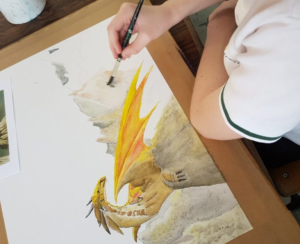Curriculum Statement
“Purpose of study
Art, craft and design embody some of the highest forms of human creativity. A high-quality art and design education should engage, inspire and challenge pupils, equipping them with the knowledge and skills to experiment, invent and create their own works of art, craft and design. As pupils progress, they should be able to think critically and develop a more rigorous understanding of art and design. They should also know how art and design both reflect and shape our history, and contribute to the culture, creativity and wealth of our nation.”

UWS embraces the statutory guidance and fully supports the study of Art and design at KS3. A significant number of students continue to enjoy the subject in Key stage 4 and for GCSE. The department sees the enjoyment of the subject and the confidence to work independently as being highly valued.
KS3
“At KS3 pupils should be taught:
- to use a range of techniques to record their observations in sketchbooks, journals and other media as a basis for exploring their ideas
- to use a range of techniques and media, including painting
- to increase their proficiency in the handling of different materials
- to analyse and evaluate their own work, and that of others, in order to strengthen the visual impact or applications of their work
- about the history of art, craft, design and architecture, including periods, styles and major movements from ancient times up to the present day”
At UWS we plan the Art schemes of work to address the above. An important part of this is to have 3 shorter teacher directed projects in Year 7 and 8 which concentrate on the formal elements of art (line, shape, form, colour, tone, texture, pattern and space), whilst also experiencing the assessment objectives delivered at Key stage 4. Students learn to use a variety of media, techniques, and processes. This is intended to build confidence and increase independent skills.
Students focus on ...
In Year 7, students begin with an identity and portraits project then journey on to view the wider world around them through the study of African art. They then study the natural world around them and their local environment.
In Year 8, students explore the work of the ancient Aboriginies then progress to view the work of the Pop artists from the 1960’s. Students then follow the creativity of animation artists such as Stan Lee and Tim Burton in a ‘telling stories’ project.
As well as completing pieces common to all, pupils are required to extend and develop ideas of their own through independent homework and competition entries.
During Year 9, students will produce work based on ‘Animals and pets’ as a starting point. They will use a wide range of materials and processes to present work both in two and three dimensions. The project will cover aspects of work form various artists to include ‘Beatrix Potter, ‘Vincent Scarpace’, ‘Adrienne Craddock’, ‘Nolon Stacey’ and ’Caitlin Hackett’. Students will research information about these artists and evaluate and analyse their work. They will experiment with colour, pattern and mark making to produce artists studies. They will also produce observational drawings of cats, rabbits, fish and dogs. All are encouraged to annotate their work appropriately and to explain their ideas and insights.
KS4 (GCSE Art)
Art is a popular choice at GCSE. Candidates are entered for the AQA GCSE – Art and Design: Fine Art.
The specification reflects the resources available in staffing, equipment, and accommodation. Candidates can submit work in any media as part of their portfolio but drawing and painting will be common to all.
The AQA Specification is planned so that all students produce work to support the 4 assessment objectives, aiming to produce work of a confident standard. The portfolio must include an extended project that has a clear starting point or theme, and a journey to realise final intentions. At UWS all candidates complete a project which is based on ‘a view from above, and patterns in nature’.
This project will give students the opportunity to demonstrate, through an extended and creative response, their ability to draw together different areas of knowledge, skills, and/or understanding. Students must provide evidence of drawing activity and written annotation. Work selected for the portfolio should be presented as mounted studies, in sketchbooks, visual diaries, journals, design sheets, design proposals, models, maquettes, prototypes, storyboards, video, photographic or digital presentations. The aim of the project is to enable students to independently engage in a creative process of Art focusing on observing natural forms in the environment as a “view from above”. Students will explore images and artefacts from insects, shells, fossils, flora, and fauna. Students will take risks and explore and experiment with ideas, processes, media, materials and techniques through drawing, painting, collaging, print making, and sculpting. Students will develop critical understanding through investigating the artists Alex Konahin, Alicia Merret, the Boyle family, and Andy Goldsworthy.
The project is launched at the start of Year 10 and runs through until May in Year 11. Students are also expected to submit ‘other works’ to support their coursework portfolio. This might be a series of prints, collages, drawings, or sculptures and will have been produced independently based on the pupils own chosen theme.
The second component is the ‘Externally Set Assignment’ – seven starting points provided by AQA. These are made available at the first timetabled Year 11 lesson in January and students choose one starting point. After unlimited preparation time they complete their final piece during a 10 hour supervised period (usually two days in April).
OP ART | Overview of Op Art, study two named artists, present work creatively. Work presented in sketchbook. Overview of Op Art, study two named artists, present work creatively. Work presented in sketchbook Final outcome – Painted canvas, painting, drawing, mixed media, collage. Choice of materials and scale. |
|
MAJOR PROJECT
| Choice of themes – for example:
Choose one. Research artists who have been inspired by the above. Continue to develop your chosen theme. Use a wide variety of materials – experiment and vary the scale of your studies. Introduce drawings and photographs that you have taken that support your project. Write careful notes and annotations explaining your ideas. |
|
EXTERNALLY SET TASK
| Given to all candidates on the first week back in Spring Term of year 11 Unlimited preparatory time leading up to the 10 hours Examination in May 2015 |
|
Year 10: Summary of work completed, including time scales.
Complete OP ART and start the MAJOR PROJECT
Year 11: Summary of work completed, including time scales.
Complete MAJOR PROJECT before Christmas Holiday, then concentrate on EXTERNALLY SET TASK
Assessment
KS3: Summary how units/work is marked etc
All work is marked and reported on at least once each term. Further to this, pupils are given written feedback and marks at other points during projects as appropriate.
KS4: Summary how units/work is marked etc
All work is marked and reported on at least once each term. Pupils are given individual marks and written feedback at regular intervals where appropriate.
At the end of the Course work is marked and reviewed internally before being marked by the AQA Moderator.
Homework
KS3: Students are given a variety of homework tasks that link to their current work in class. Year 7 pupils are given shorter tasks that are completed quite readily in one session, older pupils complete longer research tasks to support ongoing projects.
KS4: It is essential the GCSE students regularly take their sketchbooks home to extend their work, especially during holidays and weekends.
Support at Home
Pupils can freely access resources and materials to take home to support their work. Included in sketchbooks are descriptions of units of work and guidance about materials and techniques to be used.
Additional Support in school and/or resources
The Art Room is available to all pupils at break and lunchtime (although on some occasions priority is given to KS4 students). Resources are freely available upon request.
Extra-Curricular
The Art Department provides regular activities on Deep Learning days – these are sometimes a full day project (for example, this year a small group worked on canvas paintings after meeting a group of refugees/asylum seekers), on other occasions the work is themed with colleagues from other subject areas (such as a recent project on Global warming). These days provide an essential opportunity for pupils to work for a more sustained period, often with others, and using a greater variety of media.
We have strong links too with the annual Grassington Festival, working with visiting artists to produce art installations for display during the Festival.

